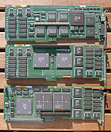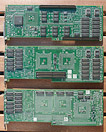Graphics
Ultra
Introduction
General
"Ultra" is the codename of an enhanced graphis option based on the same technology that was also used in Express graphics options. Typically it is used in Indigo 2 systems, but there is also an Adaptor to use it in Onyx or Challenge L systems.
Technology
Overview
This is a functional overview of the Ultra graphics options:
- The operations begin with a command token and data being written into the FIFO.
- From there the Command Parser these are read and fed into the Geometry Engines for execution.
- The Geometry Engines perform per vertex and slope calculations on the data and write the results into an output FIFO.
- From that FIFO the data is read by the Raster Engines which include edge and span processing and convert primitives into pixels.
- The Raster Engines do also per-pixel operations and write pixel data to the framebuffer.
Boards
Indigo 2
The Ultra boardset consists of the following three boards:
- GU1
- This board houses the HQ2 command engine, 4 GE7 geomtry engines (2 on one chip). The connection to the backplane is on this board.
- RU1
- The 2 RE3.1 Raster Engines are placed on this board.
- VB2
- Aside from a video I/O slot this board also contains the RAMDAC. All external connectors are on this board.
Onyx
Not much is known about the boardset for the Onyx. But whatever it is it might be safe to say that it requires some kind of extension to the original boards to plug them into the Onyx backplane.
Setup
Indigo 2
The Extreme boardset consists of three boards connected together. The graphics option uses only one GIO64 connector. If other GIO64 options are present it is essential that each one runs on a logical GIO64 bus on it's own.
Onyx
Because the Onyx does not feature a GIO64 bus in it's system an interface board is required to use an Extreme boardset in such a system.




